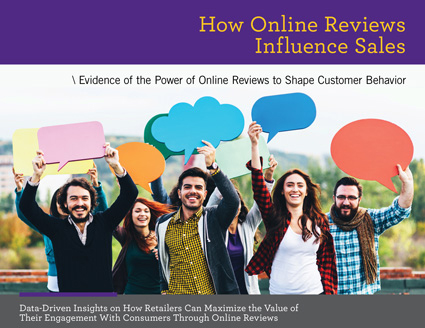How Online Reviews Influence Sales
Evidence of the Power of Online Reviews to Shape Customer Behavior
Marketers, as you deploy your holiday strategy, take a close look at what your online reviews are signaling to shoppers, because in the peak gifting season, those reviews can be the difference between a sale and a scroll-past. Research from the Medill Spiegel Research Center shows how online reviews shape conversion rates, especially for higher-priced gifts. These findings, first published in 2017, remain highly relevant today.
As part of the Medill Spiegel Research Center’s ongoing, multi-faceted examination of consumer engagement, we have led extensive research into how online reviews shape financial outcomes. Our findings reveal just how powerful consumer feedback can be in driving sales. Take a look at the report below.
We found that online reviews have a significant and quantifiable impact on purchase decisions – but the degree of that impact depends on a number of factors, such as star ratings, the nature of the review content, the number of reviews, the price of the item, and the source of the review.
These findings have powerful implications for retailers and their suppliers as they think about how to collect, manage, and promote online reviews of their products and services.
Questions We Address
- What is the upside impact of online reviews on sales? What’s the downside impact?
- Are higher ratings always better predictors of increases in sales?
- Does familiarity with the product category alter the influence of reviews?
- Is there an optimal number of reviews? If so, how many?
- Should brands prompt purchasers to submit reviews?
- Do reviews from verified buyers have greater impact on sales than those from anonymous sources?
Insights into How Online Reviews Affect Purchase Decisions
As products begin displaying reviews, conversion rates escalate rapidly. The purchase likelihood for a product with five reviews is 270% greater than the purchase likelihood of a product with no reviews. But having more reviews isn’t necessarily better, after a point. The marginal benefit of additional reviews begins diminishing rapidly after the first five reviews.
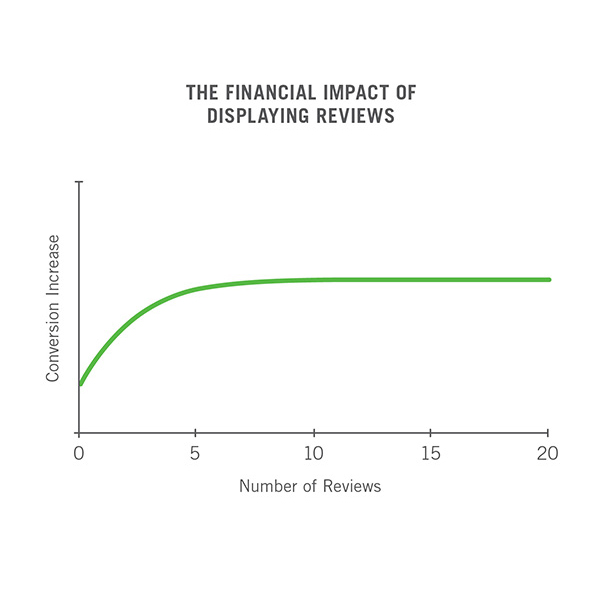
Higher-Priced Products, Higher Conversion Impact
Reviews have a greater impact on purchase likelihood for higher-priced items than cheaper ones. Our research found that when reviews were displayed for a lower-priced product, the conversion rate increased 190%. However, for a higher-priced product, the conversion rate increased 380%.
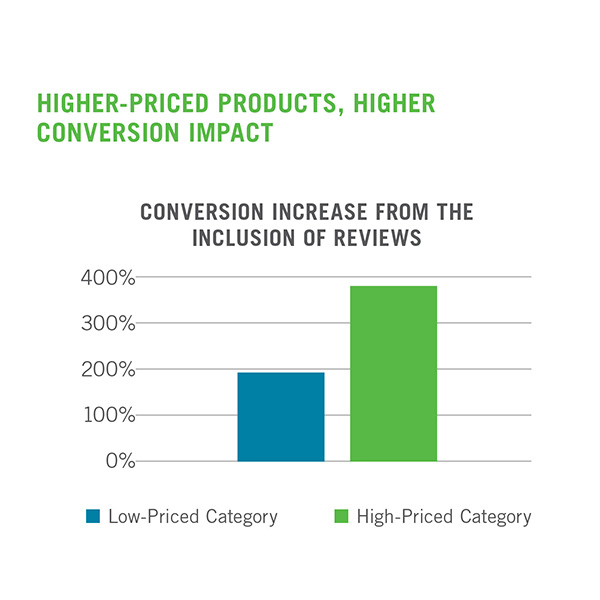
Is five stars “too good to be true” in the eyes of consumers? According to our research, it is. Across product categories, we found that purchase likelihood typically peaks at ratings in the 4.0 – 4.7 range, and then begins to decrease as ratings approach 5.0.
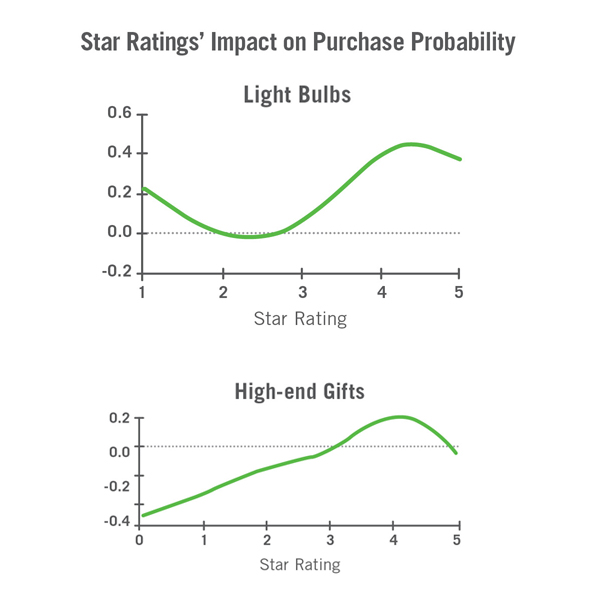
Reviews from verified buyers are substantially more positive than reviews written by anonymous sources. We found that verified buyers are more likely to give four- or five-star ratings than anonymous reviewers are. Conversely, anonymous buyers are significantly more likely to give one- and two-star reviews.
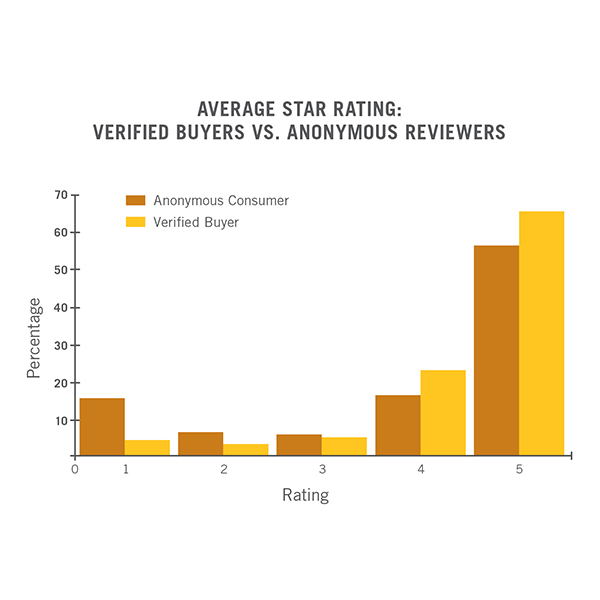
Data-Driven Strategies to Leverage the Power of Online Reviews
- Based on SRC’s extensive research into how online reviews influence purchase decisions, we recommend that retailers follow these six principles when developing an online review strategy:
- Display reviews and ratings on your product website: Retailers that choose not to feature ratings and reviews risk losing customers to a site that does.
- Embrace negative reviews: While it may seem counterintuitive, negative reviews can have a positive impact because they establish credibility and authenticity.
- Prioritize generating reviews for products with a low volume of reviews: Retailers should focus their efforts on making sure all products have at least a handful of reviews.
- Further prioritize generating reviews for higher-price and higher-consideration products: Retailers can help consumers overcome the risk of buying expensive or unfamiliar items by sharing additional reviews for these products.
- Overcome selection bias to improve the value of reviews: A larger pool of reviewers is not always more representative, particularly if it includes a large number of anonymous reviews.
- Identify reviews from “verified buyers:” Identifying purchasers with “verified buyer badges” enhances the credibility of a review and improves the odds of purchase by 15%.
Learn more about these strategies in our report, How Online Reviews Influence Sales: Evidence of the Power of Online Reviews to Shape Customer Behavior.RC
Dive Deeper into Online Reviews
- To learn more about SRC’s research into how engagement via online reviews influences purchase behavior and customer value, we invite you to explore our full library of content on the subject.
Other Studies
- Online Negative Word of Mouth: Do negative posts in a social media environment impact purchase behavior? To answer this question, Air Miles Reward Program provided Spiegel researchers a database of purchase behavior and social media posts that were the result of a policy change announcement largely viewed as negative.
Read study - Self-Motivated vs. Prompted Reviews: How does self-selection impact star ratings for online reviews? Using data supplied by PowerReviews, Spiegel researchers analyzed how ratings in customer reviews varied depending on if a customer was a verified buyer or an anonymous consumer.
Read study
Published Research
The results and insights from the Medill Spiegel Research Center’s research into how online reviews influence consumer engagement have been published in the following journals and textbooks:
- Askalidis, Y., Kim, S.J., and Malthouse, E.C. (2017), Understanding and Overcoming Biases in Customer Reviews. Decision Support Systems. 97 (May 2017), 23-30
- Maslowska, E., Malthouse, E.C., and Bernritter, S. (2017), Too Good to be True: The Role of Online Reviews’ Features in Probability to Buy, International Journal of Advertising, 36(1) 142-163.
- Askalidis, G., and Malthouse, E. C. (2016). The Value of Online Customer Reviews. RecSys 2016 – Proceedings of the 10th ACM Conference on Recommender Systems, 155-158. Association for Computing Machinery, Inc.
- Kim, S.J., Wang, R. J.H., Maslowska, E., & Malthouse, E.C. (2016), “Understanding a Fury in Your Words”: The Effects of Posting and Viewing Electronic Negative Word-of-Mouth on Purchase Behaviors. Computers in Human Behavior, 54, 511-521.
- Kim, S., Wang, R., and Malthouse, E. (2016). The Effects of Online Negative Word-of-Mouth: An Empirical Study. In Let’s Get Engaged! Crossing The Threshold of Marketing’s Engagement Era. Edited by Michael W. Obal, Krey, N., & Bushardt, C. Springer International Publishing.
- Kim, S., Wang, R., and Malthouse, E. (2014). The Good and the Bad of Negative Word-of-Mouth: An Empirical Investigation into the Effect of Online Messages. Advances in Advertising Research, Volume V.
- Kim, S., Wang, R., and Malthouse, E. (2013). How Negative is Negative Word-of-Mouth? The Effects of Posting and Viewing Electronic Negative Word-of-Mouth on Customer Purchase Behaviors. 2013. American Academy of Advertising Global Conference Proceedings.

